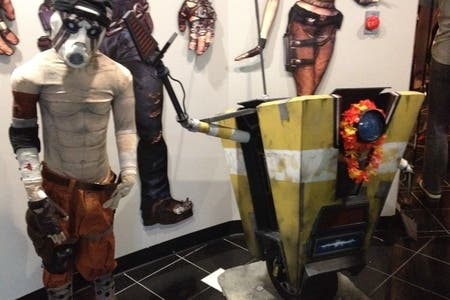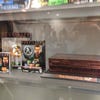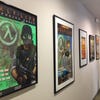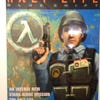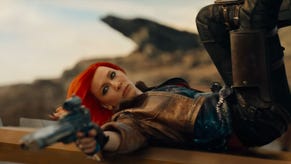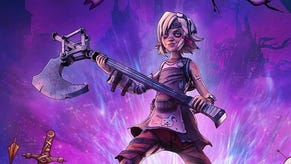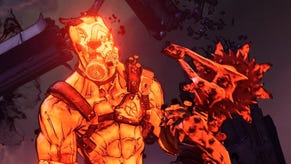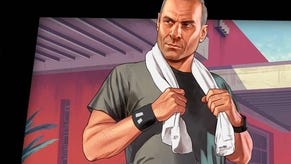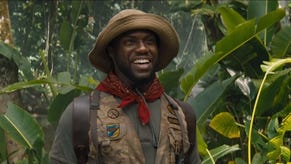How Gearbox broke the bank for Borderlands 2
With Half-Life ports a distant memory, we explore the Texas developer's 12th floor.
Borderlands 2 was built in a bank.
That is, the Bank of America building in Plano, Texas, just outside Dallas. And, specifically, the 12th floor of the Bank of America building in Plano, Texas, just outside Dallas.
But let's start at the top, on 13, or, as Gearbox marketing chief Adam Fletcher describes it, the Penthouse Floor. Here the developer's executives, human resources, marketing and PR staff get on with the business of doing business in offices with glass doors. Gearbox's outspoken boss Randy Pitchford isn't in his today (he's giving VIPs the tour), yet his presence is impossible to ignore. It's a game museum of sorts - every console ever released is perched up on a shelf, wrapping around his desk amid trophies and other signs of his company's considerable success. Unusually, his monitor faces the lobby, clearly visible through the glass doors. This, I'm told, is because Randy wants his staff to see what he's up to. He wants them to knock on his door and say, hey, that looks cool. What is it?
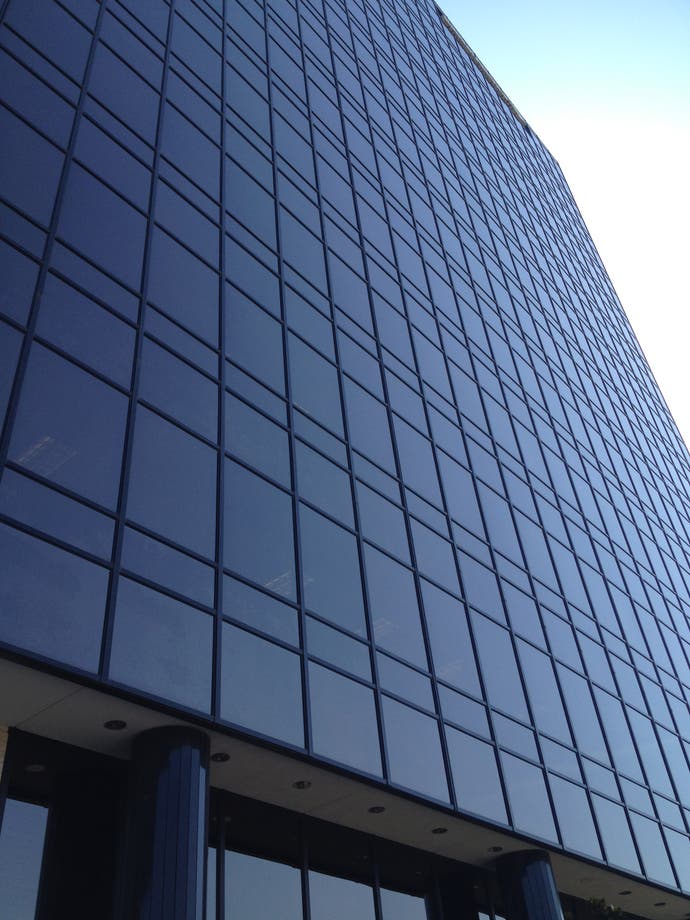
Nearby the Claptrap Tower, a crazy assortment of boxes piled on top of each other, protrudes out from the floor up to the ceiling. The cheeky robot, for many the face of Borderlands, is voiced by Gearbox's VP of business development and licensing David Eddings. His office, packed with merchandise, is nearby. How odd it must be to see that tower every day.
We take the lift down one to 12. With Borderlands 2 finished it's mostly deserted (it's just after 10am, and most staff are yet to turn up for work anyway). Here the Borderlands 2 live team and the Gearbox art team, which works across all projects, will beaver away, usually a handful to a room packed with computers and huge monitors, on downloadable content. Also here is Gearbox's custom focus test room, which, 10 months ago, proved a huge help in guiding the game along the path of fun.
I like to think of it as a steak. This is a game that's really a steak. It's deep, it's juicy, it's good. And tomorrow, I would love to have another steak - Borderlands 2 lead designer John Hemingway
12 is where Gearbox began, before success claimed 11 and 13. You can see evidence of this as soon as you step through the doors of the lobby. Glass cabinets are packed with awards, toys and old Gearbox games. The first Halo game on PC. Brothers in Arms games. Duke Nukem Forever and, of course, Borderlands 1. But one game in particular catches my eye.
On the left hand side of the room, facing the reception desk, is a glass cabinet with a gold master of the Dreamcast version of Half-Life - a port Gearbox finished but was never released. It crystallises in my mind how far Gearbox has come. For so many years it was a work for hire specialist, taking care of ports of games others had made and fleshing out expansions. It made half a dozen Half-Life games in its early days as Pitchford got the studio off the ground with Valve's help. Then, some middle of the road World War 2 shooters in its own Brothers in Arms series. But it wasn't until the release of Borderlands in 2009 that Gearbox broke out.
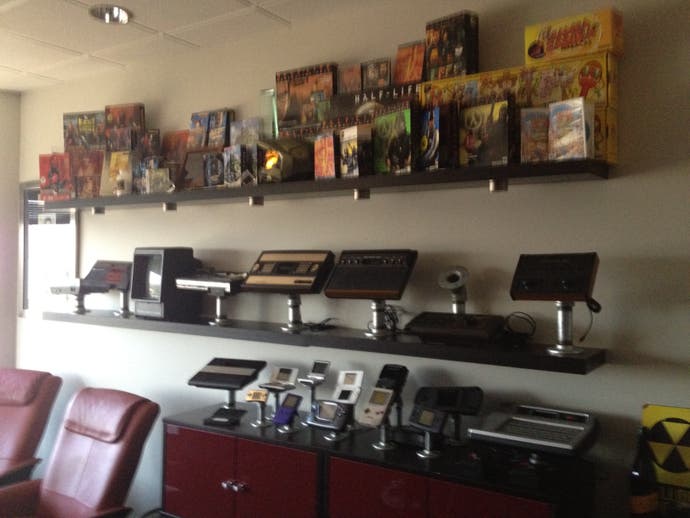
It was an unprecedented success for the studio, and a unique one for publisher 2K Games. Here was a first-person shooter that underwent a drastic art style change late in development to help it stand out amid the increasingly crowded FPS genre. The decision paid off. Borderlands went on to sell around five million copies and became the best-selling new IP of the year.
The idea behind Borderlands' gameplay was a simple one that now seems obvious: Diablo with guns. And it comes as no surprise to learn that pretty much everyone at the company has played Blizzard's loot grind behemoth. "Back when I was in college my friends and I always talked about a game, and said, you know what I really want? I really want to play a first-person shooter and Diablo together," Borderlands lead designer John Hemingway tells me. "That's our dream game. We all went our separate ways. I ended up going into the game industry. I interviewed with Gearbox, and they had just started development of Borderlands and they showed me what they had. My jaw dropped. I must work on this game. I got hired and here I am."

The influence of Diablo on Borderlands cannot be understated. Four-player co-op and endless, random loot, over and over and over again, in first-person, with lots of guns. "When we first announced Borderlands a lot of people said, this is the game I've always wanted," Hemingway continues. "I didn't know it until now, but this is the game I always wanted to play."
There was more to Borderlands' success than that of course. Rather than launch big and burn out, Borderlands sales kept up for months after release, fuelled by positive word of mouth, its co-op and wonderful downloadable content.
"I like to think of it as a steak," Hemingway says. "This is a game that's really a steak. It's deep, it's juicy, it's good. And tomorrow, I would love to have another steak. Some games aren't like that. They're much more like candy or cake. Oh, I'll eat cake, and now I'm sick of cake, I don't want it any more. I'm done. Borderlands is such a good game that it doesn't do that. It's got some magic there."
As Borderlands sales increased so did the budget for Borderlands 2. And with more money for development came increased scope. Borderlands 2 is a huge game, with a script about six times as large as Borderlands'. There are five character classes, up from four, more weapons, more unique items, more varied environments, over 300 enemy types and an infinite, profile-wide levelling system. Borderlands 2 is riding the hype train to happy hardcore town, and it's already setting records. It is 2K's most pre-ordered game ever (something that blows Hemingway's mind) - and in terms of Take-Two games, is beaten to the pre-order punch by Grand Theft Auto 4 and San Andreas only.
Knowing this, it's no surprise to find Gearbox has its own motion capture studio. Most developers outsource this part of production to specialists rather than house their own costly studio. It's what you'd expect - dark, open, with lots of cameras all around. But something stands out: a replica pulse rifle from Aliens. Adam says it's an actual working shotgun. A real working shotgun, just lying on a chair. Welcome to Texas.
Gearbox has been recognised for its love affair with guns. Borderlands holds the Guinness World Record for the most weapons in a video game (17.75 million). Borderlands 2 will outdo that, though, with more, although Gearbox doesn't know how many are in it (Randy believes it's up to an independent party to verify the number). But it's an obsession that has got the studio into trouble on more than one occasion, too. Bank of America staff have on a couple of occasions called the police because they've seen people get in the ground floor lift carrying guns. It was Gearbox staff, of course, with weapons for research purposes. But that didn't stop SWAT teams - actual SWAT teams - knocking on the door. They stayed for a while, Adam reports with a grin. Oh, and Gearbox is banned from the building roof for messing about with fireworks that sound like gunshots.
I pop into offices dotted throughout the 12th floor. I see Matt Armstrong's desk. He made all the weapons. Jeramy Cooke, the art director, made all the various character customisations (new for Borderlands 2). Jason Reece, the lead level designer, moves about the gargantuan world of Pandora in free mode on his computer. Lead visual animator Dia Hadley shows us how animations power the ever changing state of the game's many enemies. Later, he dons the motion capture suit, complete with balls, and pretends to be shot over and over again as a colleague records the action.
People always ask us, what's the hardest thing about making Borderlands 2? And our answer is always, not screwing it up - Hemingway
Everything about Borderlands 2 feels better. Each feature has been iterated, improved and expanded. Why tinker too much when the formula that served Borderlands so well is still so good? "People always ask us, what's the hardest thing about making Borderlands 2? And our answer is always, not screwing it up," Hemingway says. "Borderlands has such an amazing magic where you just want to play for five more minutes. We wanted to make sure we maintained that."
It's easy to imagine Gearbox as a gung-ho studio employing no more a sophisticated development strategy than bigger, better and more badass. But that betrays a deftness you only notice once you play the game for more than a few hours and chat with those who built it. It's wonderfully written (some of the voice acting is the best I've heard in a video game), it's packed with neat ideas (some of which are genuinely new), but it's the attention to detail that sparks the biggest grin.
For example, the character customisation system allows players to create a unique look for their class. There are nine colours for each skin and some skins based on Pandora's handful of weapons manufacturers. Drape the Siren in the Russian-style skin and a mole will magically appear on her face. "The ideal situation is there are six million other people who are playing the game and I'm different than all of them," Hemingway says.
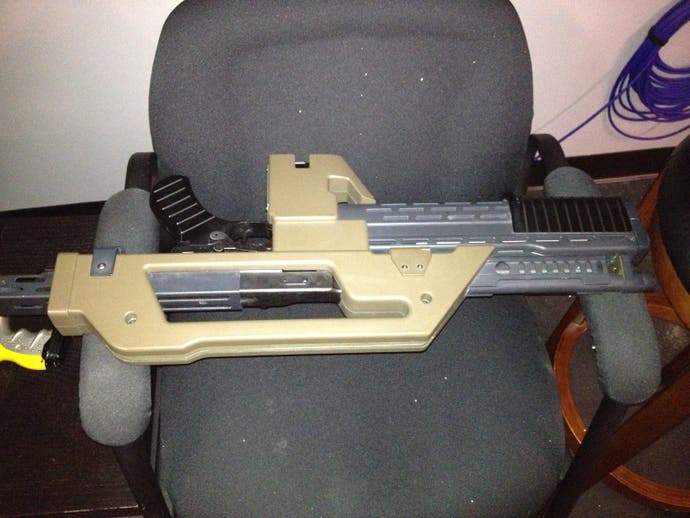
So much of what made Borderlands great was how over-the-top and zany it was. But Borderlands 2 ups the ante in this regard considerably. This is the result of what I like best about the studio: it's willing to give its staff the freedom to try stuff out, however mental. Sometimes it works. Sometimes it doesn't. But nothing is ever rejected outright.
Kansan concept designer Scott Kester is Borderlands' unsung hero. He designed all of the characters, many of the enemies and much of the world. He, alongside his colleagues, created sheets and sheets of drawings of helmets and heads and all the rest of it. A few months later, he would be surprised to see something he thought of as little more than an innocent doodle turn up in the game.
Kester designed Borderlands 2's slow moving Nomad enemies to carry huge shields. Enemy expert Ruben Cabrera, a 3DRealms veteran of nine years, then suggested Kester strap a Midget, one of Borderlands' diminutive psychotic mutant bandits, to it - so when players shoot the chain, the Midget comes clean off. That's great. Done and done, you'd think. Not quite. Kester and Cabrera thought it would be funny to strap two Midgets to the shield. Then three. Now, that's in the game.
"A large motto here is if you really care about something, just do it, and it will probably work," Kester says. "Unless you're completely going out, really bizarre. A lot of things fly here, which is cool, as long as you commit to it and do it and prove it works. That's why people will be pretty surprised by a lot of the stuff they fight in this one. We were crazy in the first game, and a little more so in the DLC. But going into this game we set our bar pretty high. We did more than I thought we were going to be able to."
A large motto here is if you really care about something, just do it, and it will probably work - concept designer Scott Kester
Gearbox isn't afraid to start over, either. Say what you will about Randy Pitchford, his team isn't afraid to go back to the drawing board, even when it's least appropriate, and for that he deserves enormous credit. The last minute art style switch made to the first game is perhaps the most high-profile example of this, and Kester was one who pushed hard for the bold black lines that better suited the over-the-top, schizophrenic tone of the game. "Having some time to digest what we had done and moving into this game, we learned a lot," he says. "We were able to optimise things. I don't say this to be egotistical about our team, but if you just took the textures from our game and put them into books, they're beautiful. They're all hand inked. They're absolutely gorgeous. But in doing that, the more you draw, the better you're going to get."
Gearbox continued its bold development style into Borderlands 2. Here we have a game that features five all new playable character classes when you'd think it would have been easier and cheaper to simply present the four from the first game with a few bells and whistles.
"I was one of the people early on who was like, let's make all new characters," Kester reveals. "I had a blast doing the old characters, but we were in a different mindset then. I lined up the old guys, saw their body types and their archetypes, and I wanted to create new body styles and types of looks."

So, Lilith, Roland, Brick and Mordecai are replaced by Salvador, Maya, Zer0 and Axton (with Gaige the Mechromancer, also designed by Kester, to follow as DLC). "They're more colourful. Right off the bat we were like, Maya has bright blue hair with bright yellow on. The old characters, Lilith and Roland, they're very homogeneous and together. We made a conscious decision to try to appeal a little more personally to different people who like the different styles of character. It was about trying to create those silhouettes and personalities and ideas that would feel familiar enough, so when somebody looks at Zer0, they can probably understand who he is and what he does just based off of what he is, but I just didn't want to draw a ninja. I enjoyed doing that and trying to give people something they don't typically have."
As I chat with Kester I notice a poster for Borderlands 2. It shows the evolution of the box art that defined the first game: a Psycho blowing his brains out with both hands shaped like guns, except where the brains and blood and bits should be are images from the game. The box art for the first game was the same, except it was just one hand, the fingers pressed into the Psycho's temple.
Borderlands' box art was the best I'd seen in a long while. It was an out there concept, a risk, a brave move on the part of developer and publisher, celebrated, proudly, screaming from shop shelves "f***ing buy me".
It was the perfect visual representation of what was great about the game, and its conception was Gearbox at its best. Initially, the team of artists who worked on the image thought US retail powerhouse Walmart would refuse to put it on their shelves. But then, against all odds, it approved it. And there it was.
"We're hoping, for better or for worse, it sticks out and people want to look at it," Kester says. "I hope we're like a train wreck. You can't help but be like, what is that thing? I've got to know more about it.
"It's all intentional. A lot of the art style change was, we had a game that was different and we wanted to distance it visually. In our trailers and all our promotional stuff we try to do that. The Borderlands personality is showing through."
Personality is key. You could argue that Borderlands was the first game Gearbox made with any of it. And its sequel is packed with it. The failed Duke Nukem Forever rescue operation was a Gearbox game in name only (Pitchford intends to build on the IP he now owns with a new game, which I imagine is planned for next generation consoles and is being built somewhere on 11). But only now, with the release of its sequel, does the Texas developer who helped keep Half-Life alive have the chance to rubber stamp a world-class franchise of its own. With the release of Borderlands Gearbox broke free from the shackles of its reputation as a reliable developer of other studios' games. With the release of Borderlands 2 it looks set to prove it was no fluke.
